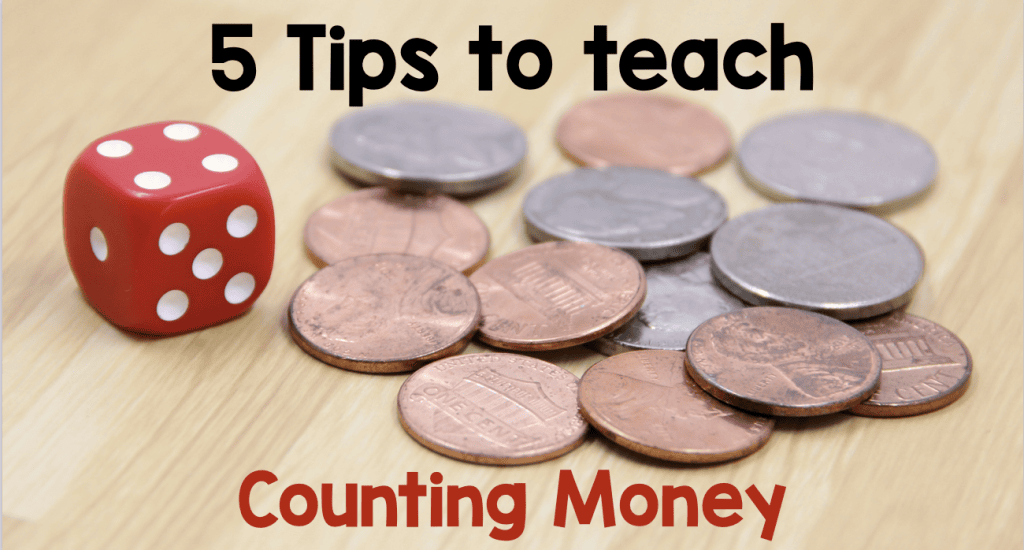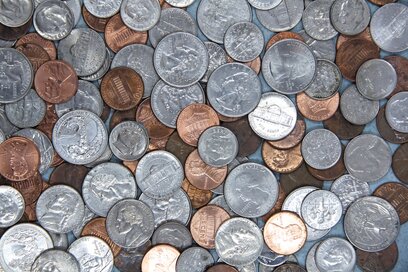How To Count Money For 2nd Graders


Learning how to teach first graders and second graders about counting money tin can exist tricky! American coin values are confusing because they don't match the size of the coin. Adding to the confusions, kids have to skip count in a number of ways in order count a mixed group of coins. I think when I commencement started didactics money to outset graders. They got SOOOO confused about switching from counting by 10s to counting by 5s. It felt similar an impossible task! But counting money is such a disquisitional life skill – I really got frustrated when these kids couldn't effigy it out!
So I consulted with co-workers and read from unlike math curriculum materials. I began to see how counting money was related to number sense and place value skills. I filled some number sense gaps for my students and provided more than intentional instruction for counting coins and it got easier for everyone. The following math activities for 2nd form and 1st grade volition make counting money easier for students (hint: the secret to success doesn't actually use coins…)
1. Focus on Skip Counting (before counting money)
Counting money requires that students be able to skip count by 5s, 10s, and 25s. Long earlier you brainstorm to teach money, practice skip counting with your students. To start, listen to each of them count by 5s and 10s – this will help you place how much exercise your class needs. In one case you take this information, you may need to add skip counting routines to your daily forenoon meeting or math routines, or you may need to run into with a small group of students to practice a few times a week. (If your students are nevertheless struggling with subitizing and number sense, check out this post for some suggestions.)
Skip Counting Songs:
To practice skip counting, you can apply skip counting songs. Jack Hartmann has some fun ones available on YouTube. Since the Jack Hartmann songs also include dancing and practice, you can easily utilise them as a brain break during your 24-hour interval. For example, in "Count by Tens and Exercise" kids do arm stretches, trunk twists, and dinosaur stomps as they count.
Skip Counting Cards:
One time kids empathise the basic routine of skip counting by 5s and 10s, you can add some skip counting cards to your math stations or math centers. While the songs assistance with hearing the design of skip counting, the cards aid students SEE the pattern of skip counting. Y'all can make your own cards from index cards or cute piffling cutting-outs for teachers. As another selection, TPT offers a wide variety of choices.

Yous tin make some skip counting cards pretty apace with pre-made cutting-out cards.
Count Around the Circumvolve:
As a forenoon coming together game, you can accept kids count around the circle. First, introduce this activity by counting by 1s, with the get-go pupil saying "1," the next saying "2" and then on. Once they empathise the concept, alter to counting by 5s or 10s. You may need to display a 100 nautical chart initially to aid students identify the next number. To go on the activity engaging, you lot can time how long information technology takes to make it all the way around the circle or to 100 (or any other number.) Merely remember to back up your students who are less confident with the skill – give them a 100-chart or make sure the are the first to say a number (because they are more likely to know the early numbers.)
2. Teach Stop and Beginning Counting:
Once your students are pretty solid with basic skip counting, you can introduce "terminate and start counting." This routine actually helps prepare kids for counting coin without having to think about coin values. Information technology is similar to counting around the circle, but y'all modify the skip counting design part way through. So you may start by having students count by 5s, then after several students (ex: five, 10, 15, xx), tell them to cease and count by 5s from the number the last child said (21, 22, 23, 24…) When you begin, only practise 5s and 1s. As students become more comfortable with the routine, you can add 10s and 25s and modify three-iv times equally yous work effectually the circumvolve (to resemble counting a mixed grouping of coins.) Expect your students to be slow the first several times, but they will option up speed every bit this becomes more familiar.
3. Innovate Counting Money with Coins Slowly:
When you actually introduce counting money with coins, start with just 2 kinds of coins (ex: nickels and pennies.) Some students volition need to exercise with only two coins for a longer time. Allow them to count real coins in a small group, or play games with just nickels and pennies. (Real coins may be easier to identify than plastic coins for kids who need additional support.)
Limit the coins on math book pages by crossing out the dimes and/or quarters for these students until they master nickel and penny combinations. Equally you add dimes, continue to provide practice with just two coins at starting time (dimes and nickels or dimes and pennies). So you lot can employ mixed groups of the three coins.

4. Provide Visual Reminders:
Because American money values do non match coin sizes (and switching betwixt kinds of coins is catchy), some students benefit from visual reminders to help them as they count.
Anchor Charts
Information technology may help your students to have an ballast chart with the coin values displayed. You might even write the skip counting pattern beneath each coin. They tin refer to this as they are counting money during games or other math activities.

An ballast nautical chart can prompt students as they count coins
Dot Coins
If you take a few students who are having a hard time shifting between skip counting patterns while counting money, y'all might utilise "money dots" for those children. This is helpful for nickels, dimes, and quarters. With coin dots, each dot equals five. So a nickel would have i dot; a dime would accept two dots; and a quarter would have 5 dots. Then the student is able to count the coins by counting by 5s.

Each dot is worth 5 cents. This is i style to brand coin counting easier.
Use coins dots sparingly, because it is harder to transfer to counting with real coins, simply information technology could be an appropriate temporary back up for some students.
5. Exercise with Money Games:
Y'all tin can add a variety of money games to your math centers or math rotations. They tin can even be used at the terminate of whole group lessons to differentiate do (by matching the coins used to the student'due south current understanding of coins.) In one case students are familiar with the games, they can also be used as role of a soft start to your school day.
Your students will dear playing games in math – the all-time office is they won't even realize they are practicing math while they play! Hither are a few simple coin game ideas:
Coin-Die:
Create a "banking company" with existent or plastic coins (y'all can limit it to nickels and pennies, or exercise a variety of coins.) Students coil the dice and take that many pennies. Once they accept five pennies, they put the pennies in the depository financial institution and exchange for a nickel. If you play with more coins, they can also exchange coins for dimes and quarters. Continue playing until one kid reaches $1.00. (This game is And then like shooting fish in a barrel to utilise for differentiation!)

Coin Grab:
Place coins in a small bag or sock. (Once again, yous tin vary the coins to meet student needs). Actor i reaches in and grabs v coins (she may choose to pull them out one at a fourth dimension). And so player two grabs 5 coins. Players count coins. The thespian with the greatest value win this round. On the side by side round player two grabs coins first.

Coin War:
Coin War is played similar the traditional card game State of war. Each player turns over a carte and counts the coins shown. The player with the greatest value wins both cards. When at that place is a tie (a state of war), students plow over a new card and the winner takes all the cards from that round. Visit my TPT store to notice this printable game to count money. The cards are organized past money type, so it's easy to differentiate for beginners and experts!

Coin War is a quick and easy way to practice counting coins. The cards are organized past coin blazon for easy differentiation.
Coin Puzzles:
Coin Puzzles are a corking addition to a math station. To complete the puzzles, students match sets of coins to their value. Numerous versions exist – some include only one set of coins per value; others include multiple coin combinations for each value.

Coin Puzzles are a great addition to math centers.
Past being intentional in your instruction (focusing first on skip counting, then slowly introducing combinations of coins) you can make counting money easy for your students. Teaching money will be enjoyable and rewarding for everyone involved!
Hither'southward where you can purchase the games used in this post:
- Coin State of war
- Coin Puzzles
You might also like:
- Educational activity Place Value to 1st Graders
- How to Apply Subitizing Cards in the Classroom
- ix Simple but Fun Math Games for Kids

Source: https://primarydelightteaching.com/how-to-teach-counting-money-1st-2nd-grade/
Posted by: leetersibithe1997.blogspot.com

0 Response to "How To Count Money For 2nd Graders"
Post a Comment